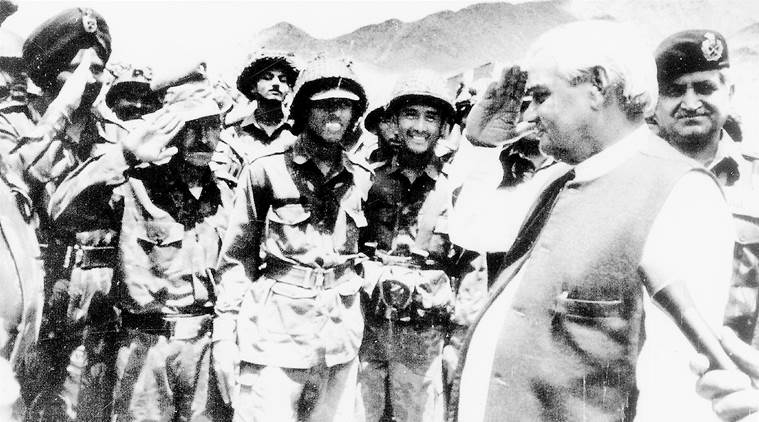Sushant Singh
Prime Minister Atal Bihari Vajpayee with troops in Kargil in June 1999. (Express archive)
 While much of what happened during the war on the icy heights of Kargil in 1999 has been extensively debated and analysed, little known are the details of how senior ministers of the Atal Bihari Vajpayee cabinet first learnt of the intrusions in the area. They got to know of it rather fortuitously, after a senior Army officer approached the son of then Foreign Minister Jaswant Singh.
While much of what happened during the war on the icy heights of Kargil in 1999 has been extensively debated and analysed, little known are the details of how senior ministers of the Atal Bihari Vajpayee cabinet first learnt of the intrusions in the area. They got to know of it rather fortuitously, after a senior Army officer approached the son of then Foreign Minister Jaswant Singh.
Manvendra Singh, son of Jaswant Singh, and a Territorial Army officer, said, “I was then covering defence for The Indian Express, with well-established contacts and friends in the Defence ministry and the Services headquarters. At the beginning of the second week of May, I got a call from a senior officer in Army Headquarters that I should positively see him that evening.” This was in May 1999.
“I met him for dinner at his residence where he told me that something was happening in Drass-Kargil sector which seems to be serious because a Special Forces unit had been heli-lifted urgently that day and taken to the heights in that sector,” said Singh, who later became an MP and a MLA in Rajasthan.
“When I enquired more, he said that it was some problem with the Line of Control (LoC) management and there are intruders suspected to be in that sector. As a military man, he asked me to convey the same to the political leadership through my father as the matter was serious,” added Singh.
Singh met his father very early next morning and asked if he was aware of any reports of a major problem in the Drass-Kargil sector. Jaswant Singh replied in the negative and reached for his RAX phone.
“He called his colleague George Fernandes, who was the Raksha Mantri, and asked if he was aware of some unusual happenings in the Drass-Kargil sector, to which Fernandes said no. He told my father that he was due to leave abroad on a reciprocal visit that day. My father suggested that before he leaves, he should ask for a briefing in the Operations Room of the Military Operations directorate for both of them,” said Singh.
Both the ministers were briefed by the Director General Military Operations (DGMO) and informed about the intrusions, but not the full extent or the nature of intrusions or the presence of regular Pakistan Army soldiers. It later came to light that the local Army formations had kept the Army Headquarters in the dark even as they were discovering the truth about the intrusions in the Drass-Kargil-Batalik sectors.
As per the Kargil Review Committee report, there were around 140 posts and pickets established by regulars of Pakistan Army, over a frontage of 100 km up to a depth of 8 km inside Indian territory over months in 1999. The Indian Army had first detected the intrusions on May 6, 1999, and the then Corps Commander Lt Gen Kishan Pal had said a week later that “the situation was local and would be dealt with locally”.
In his book, A Call to Honour, Jaswant Singh notes that “there was however, a clear contradiction between assertions of ‘early intercepts,’ of them being Pakistan Army etc. and then simultaneously (Vice Chief of Army Staff saying that intruders were) ‘irregulars and terrorists’, all this I just could not reconcile to.”
After being briefed by the DGMO that morning, the two ministers informed Prime Minister Vajpayee and then the political leadership swung into action taking direct control of the conflict between two nuclear-armed neighbours. In the first briefing by the DGMO for PM Vajpayee on May 18, Jaswant Singh notes he was given an assessment by the Army that it would take about ‘two or three weeks or so’ to “clear the area”. The war, was to eventually culminate many weeks later, on July 26, the day now celebrated as Kargil Vijay Diwas.
No comments:
Post a Comment